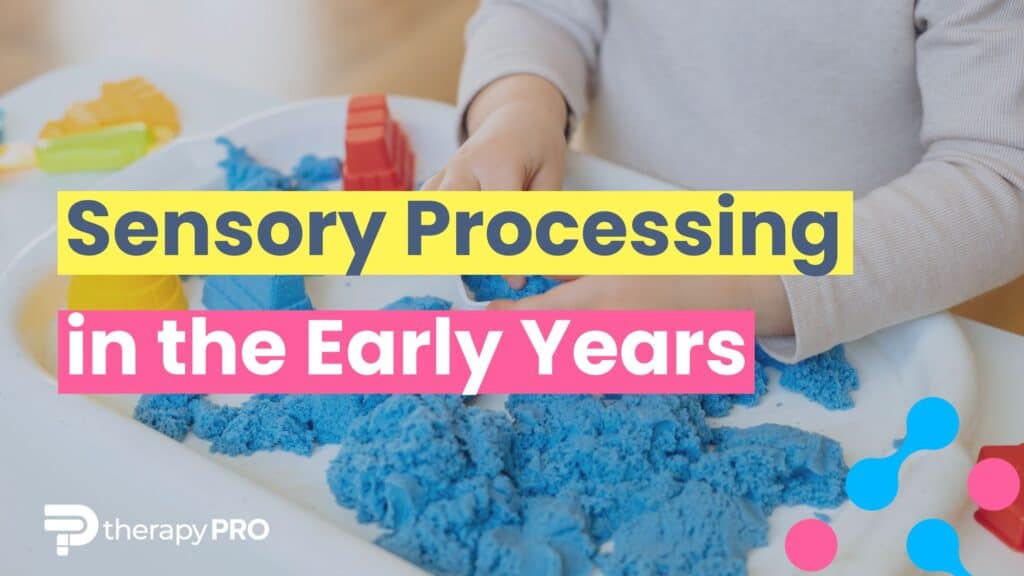Sensory Processing In The Early Years: Empowering Your Sensory-Sensitive Child
Sensory processing issues frequently come to light in the early stages of childhood.
It’s during these formative years that parents might first notice their child’s sensory sensitivities; be it an overwhelming aversion to loud noises, bright lights, or the strong dislike of clothes that feel itchy or too tight.
Parents might also spot signs of gross motor coordination difficulties, such as an obvious clumsiness or trouble with navigating stairs. Kids may also struggle with fine motor tasks such as grasping a pencil tightly or frustrations in doing up buttons.
In this article we shed some light on understanding sensory processing challenges and why it’s important to help your child regulate their senses. We’ll also outline some practical strategies you can do at home to support your sensory-sensitive child.
Understanding Sensory Processing
In the hustle and bustle of the world we live in, our senses are our guide.
For children with sensory processing challenges, navigating this world can feel like trying to tune into a radio station with a poor signal.
Just as every child is unique, so too are their sensory experiences. Sensory processing issues can manifest in various ways, affecting how a child interacts with their environment and handles daily activities.
It’s crucial for parents to understand that sensory processing issues are not a choice, but a challenge that some children face in organising the multitude of sensory inputs they receive.
Remembering that sensory inputs are sights, sounds, tastes, and touches that we experience in our world. And for our little ones, when sensory inputs are overwhelmed, they can easily become dysregulated.
The Importance of Sensory Regulation
Sensory regulation refers to the ability to maintain a “just right” state of alertness.
This balance allows children to engage with their surroundings effectively, whether it’s being able to focus on schoolwork in a noisy classroom or enjoy a family gathering in a large open park.
However, children with sensory sensitivities may struggle to filter out irrelevant stimuli or may seek out additional sensory input to feel balanced.
Recognising this need is the first step in supporting your child through their sensory journey.
Here are some common examples of sensory regulation challenges faced by sensory-sensitive kids:
- Overwhelm in busy environments: A child might become easily overwhelmed in places like grocery stores or playgrounds, where the level of noise, visual stimuli, and movement is high. They might cover their ears, become irritable, or have a meltdown.
- Seeking sensory input: Some children might seek intense sensory experiences, such as spinning, jumping, or touching everything they see, to feel “just right.”
- Difficulty with transitions: Moving from one activity to another can be particularly challenging for sensory-sensitive children, as the change itself can be disorienting.
- Difficulty with focus and attention in class: Sensory-sensitive children may find it hard to concentrate on tasks at school due to the sensory-rich environment.
Strategies for Supporting Your Child
Parents play a pivotal role in helping their children navigate sensory challenges.
Here are some tried and tested, practical strategies that you can implement at home to support your child.
Create a Sensory-Friendly Environment
Tailor your home environment to support your child’s sensory needs. This might involve reducing clutter, using soothing colours, or incorporating soft lighting.
For children who are easily overwhelmed by noise, consider creating quiet spaces where they can retreat and regroup.
Introduce a Sensory Schedule
A sensory schedule is a planned and scheduled activity program designed to meet a child’s specific sensory needs. This might include activities that provide deep pressure, like bear hugs, or vestibular input, like swinging.
Work with an occupational therapist to create a personalised sensory schedule for your child.
Embrace Detective Work
Observe your child to understand their sensory preferences and triggers. What activities or environments lead to calmness or distress?
Sharing these observations with a therapist can help tailor interventions that meet your child’s unique needs.
Practice Co-Regulation
Young children often require assistance to regulate their sensory experiences. Be attuned to signs of sensory overload and offer strategies to help your child return to a “just right” state.
This might include deep breathing exercises, providing a favourite sensory toy, or offering a quiet space to decompress.
Client Success Stories
Therapy Pro occupational therapists have a deep clinical experience in crafting solutions to help address the unique sensory needs of children.
It’s all about supporting kids to make everyday situations more manageable and enjoyable for them and their families.
Here are a few client success stories that showcase the transformative power of these strategies and the impact understanding and accommodating sensory needs can have on a child’s life.
Each story highlights the creativity, collaboration, and commitment of Therapy Pro’s team in harnessing the power of sensory strategies to support children with sensory processing challenges.
Elastic Resistive Band for Classroom Focus
One child, who struggled with staying seated and focused during class due to their need for constant movement, found a game-changing solution through the simple addition of an elastic resistive band around the legs of their chair.
This modification allowed the child to quietly bounce their feet against the band, providing the necessary sensory input to stay calm and attentive without distracting their peers.
As a result, the child’s classroom participation and learning experience improved significantly.
Auditory Comfort with the ABC Song
Another child, prone to anxiety and sensory overload, discovered a source of calm in the familiar tune of the ABC song.
Whenever feelings of overwhelm began to surface, singing or listening to this song provided a soothing auditory input that helped them regain composure and a sense of security.
This strategy was not only effective at home but also served as a mobile tool for managing stress in various settings.
Sensory-Friendly Clothing Adaptation
A young girl with tactile sensitivities found daily dressing particularly distressing, especially with clothing textures and itchy tags.
Her family and OT designed a wardrobe of sensory-friendly clothing that prioritised soft fabrics, seamless designs, and the removal of clothing tags.
This considered selection turned what was once a daily struggle into a positive, stress-free experience, enhancing the child’s comfort and self-expression.
Visual Supports for Anxiety Reduction
A detailed daily schedule and visual cues for transitions were used to support a child experiencing heighted anxiety in unpredictable environments.
These tools helped clarify the child’s day, providing a clear structure and reducing anxiety about the unknown.
With these supports in place, the child showed increased confidence and a willingness to participate in new activities, both at school and in extracurricular settings.
Seeking Professional Support
If you suspect your child has sensory processing issues or if they’ve recently been assessed, seeking professional support can make a world of difference.
The Therapy Pro for Kids team of paediatric occupational therapists specialise in sensory integration and can offer guidance, strategies, and support tailored to your child’s needs.
Understanding and supporting a child with sensory needs can be a journey of discovery for both parents and children. By embracing a warm, engaging approach and seeking professional guidance, you can empower your child to navigate their sensory world with confidence.
Remember, you’re not alone on this journey.
Contact us today to find out how we can support you and your family.




